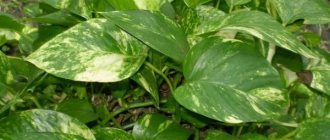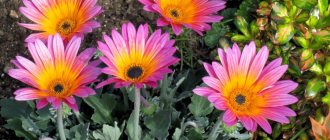Many people don’t even know what a dizygoteca flower looks like. However, this is a very amazing and original plant. Many gardeners ignore it due to its “capricious disposition” when growing. But if you adapt and fulfill all the requirements, you can grow a very cute and beautiful tree native to tropical countries, which will certainly decorate your home.
What does dizygoteca look like?
This plant belongs to the category of evergreen shrubs and trees of the Araliaceae family. It’s beautiful enough that photos of dizygotheca always turn out successful and aesthetically pleasing.
In appearance, it is a bit reminiscent of a palm tree - the smooth trunk is decorated with a spreading crown with a diameter sometimes reaching 4 meters. The height of dizygotheca when growing in natural climatic conditions is from 6 to 8 meters, but when grown indoors it is limited to two meters. As its age increases, the straight trunk of the plant begins to harden and become covered with denser bark.
The leaves of Dizygotheca are very beautiful - large and palmate, separated into 7-10 lobes. The length of one lobe can be from 10 to 30 centimeters, the edges are jagged, the lobes are united by a petiole, up to 40 cm long.
The foliage can be painted in various dark colors, such as dark red, green, and almost black shades. On the dark background of the leaf, lighter veins are visible, the same color as the petioles.
How does dizygoteca bloom? Very modest, its inflorescences are umbrella-type, very small, and therefore are not always valued as a decorative decoration.
Main types
The dizygotheca plant is represented by different varieties. Each of them has its own characteristics. There are more than 100 species in nature, but only some of them are adapted to home conditions.
In the right conditions, the tree can grow up to 150 cm
Dizygoteca elegantissima
The most common type. It is distinguished by complex serrated leaves, which are located on long petioles. On one branch there are up to 11 leaves of an elongated narrow shape. They have jagged edges.
It blooms rarely, the inflorescences are collected in umbrellas, which are white in color. They look inconspicuous and unnoticeable.
Dizygoteca Bianca
The leaves are dark green with purple veins. The edges are adorned with an irregular cream-colored edge. All this gives the plant a variegated appearance. The leaf blade rarely exceeds 9 cm in length and 1.5 cm in width. The edges are jagged with slightly smoothed apices.
Dizygoteca graceful
Grows up to 2 m in height. The leaves are long, narrow, collected in umbrellas of 11 pieces. It branches poorly, usually most of the leaves are at the top of the tree.
Other types and varieties
Dizygotheca Castor is distinguished by yellowish-white veins on the leaves. They consist of three segments and rarely exceed 9 cm in length.
The Zhemani variety is distinguished by wide leaves up to 3-4 cm, and the length of the plate reaches up to 5 cm. The central vein is reddish, the cloves are of the same shade.
Dizygoteca Veyche is distinguished by smooth edges of leaves that grow up to 4 cm wide. The description of the Kerkhova variety is no different from Veyche, only this species has a paler color.
How to properly care
Despite the fact that the plant comes from the tropics, it still prefers to grow in the shade of other trees that are taller than itself. For good growth, the growing conditions in the room must match those in nature.
Caring for dizygoteca at home involves strict adherence to criteria such as proper light, watering, humidity, etc.
Botanical description
Dizygotheca (lat. Dizygotheca) is part of the Araliaceae family and has about 17 species of plants. Dizygotheca are evergreen shrubs or small trees native to Polynesia or New Caledonia. Basically, you can buy only 1 species – Dizygotheca elegantissima. It is better for novice gardeners not to start growing indoor plants with this species, because... The plant is quite difficult to care for. Dizygoteka is close to sheflera, but requires more scrupulous and careful care. Particular attention is paid to watering, humidity, light and temperature.
Lighting
The most optimal solution would be to place the dizygoteca tree on the eastern side of the room. There is enough light and no hot afternoon sun.
It is important to maintain consistency in the position of the plant relative to the light source: you cannot turn or move it, as this may cause the tree to shed its leaves.
In winter, it is important to provide 10-12 hours of daylight. For this, you can use phytolamps or fluorescent lamps.
Top dressing
to feed dizygoteca twice a month from spring to autumn, alternating organic and mineral fertilizers.
We have prepared an interesting article for you about the poisonous Dieffenbachia plant.
Read more about caring for home gerberas in this article.
Decorative nightshade https://sad-doma.net/houseplants/decorative-leaf/paslen-komnatny.html care rules for amateur gardeners.
Air temperature and ventilation
In the room where the dizygotheca flower will grow, it is necessary to maintain the air temperature no lower than 18 degrees Celsius (otherwise the plant will shed its leaves) and no higher than 29 degrees (otherwise the plant will “burn” from the heat).
This plant loves fresh air, but despite this, it is afraid of drafts and sudden changes in temperature. In this regard, when ventilating a room in the cold season, it is important to ensure that the flower does not fall under direct air currents.
Mr. Summer Resident warns: the most common problems when caring for dizygoteca
Flower growers often make mistakes when growing plants.
| Problem with leaves, etc. | Cause | Remedy |
| The lower ones fall off. | Lack of light. | Provide diffused, bright lighting. |
| In some places they turn white, then brown. | The plant is exposed to direct sunlight. | Shade or move to another location. |
| They dry up. | Lack of moisture or too much sunlight. | Move, lower temperature. |
| They become smaller and the dizygotheca grows slowly. | Little fertilizer. | Fertilize or change the soil. |
| The flower is covered with a white coating. | Watering with hard water. | Set aside the water or add citric acid. |
| They fall off. | The air in the room is too dry, there are drafts, the flower is located next to heating devices. | Rearrange the pot, place wet pebbles on the tray, and spray. |
| They wither and droop. | Abundant watering. | Reduce the frequency of watering. |
It will take a lot of effort to obtain an ornamental shrub with graceful foliage.
Watering
This plant needs balanced watering - in hot and warm periods, abundant and regular watering is important, in the cold season it needs to be watered more moderately. If there is a lack of moisture in dizygotheca, the leaves begin to dry out; if there is too much moisture, the soil may become acidic, as a result of which fungus and other diseases develop.
To determine whether a plant needs watering, you can touch the top layer of soil. If it's dry, then it's time to water it. By the way, for this it is better to use soft water that has settled for several days at room temperature.
What to do immediately after purchase?
A newly purchased dizygotheca must be replanted immediately, since the transport soil in which it is located consists mostly of peat. Pure peat is not particularly nutritious, it does not provide much benefit to the plant, and the bush will not develop well.
At the same time, the entire soil mixture is replaced, carefully removing lumps from the roots. Good drainage is required. Then the flower is placed in a permanent place and try not to move or turn the pot unless absolutely necessary. You need to try to create all the required conditions for the plant from the first day and maintain them stably.
Dizygotheca transplant
While the plant is young, it is replanted every year in early spring. The first transplant is carried out immediately after purchase and quarantine. In this case, the roots of the dizygotheca are completely cleared of the old soil, and the plant is transplanted into new nutritious soil. For this and subsequent transplants of dizygoteca, a specialized mixture for alocasia and dracaena is well suited. It is quite loose and nutritious. You can improve it by adding a little charcoal or vermiculite, which will protect the roots from rot. You should not take a large pot for replanting. During the initial transplantation of dizygotheca, it can be the same size as the primary one, and each subsequent one is 1-1.5 cm larger in diameter than the previous one. Too much soil will promote root growth to the detriment of the growth of the above-ground part of the dizygoteca. Annual plant transplants do not have to be carried out with complete cleaning of the roots. You can limit yourself to transshipment or partial cleaning by removing part of the earthen clod and changing the drainage material. Then add fresh soil. The roots of dizygotheca should not be disturbed unless necessary. For mature plants growing in large pots, you can simply periodically change the top layer of soil.
Crown formation
To form an aesthetic crown in dizygotheca, it must be properly trimmed. If this is not done, as the plant grows, it will shed its lower leaves (which is the norm here), and eventually a straight and bare trunk will grow with leaves at the top.
Pinching the tops won't help here. To do this, the plant is radically pruned in March. The best pruning option is when you leave a very short stump of about 15 cm. New buds will begin to form and new branches will appear at the base of the trunk.
Transfer
Dizygoteca prefers loose soil that allows air and moisture to pass through well. Ready-made soil for decorative foliage plants with the addition of vermiculite and crushed charcoal to protect against root rot is suitable.
You can also prepare a mixture of equal parts:
- peat;
- coarse sand;
- humus;
- turf land;
- leafy soil.
The plant is replanted in the spring as needed, when its roots begin to appear from the drainage hole. The new pot should be one and a half times larger than the previous one.
Diseases and pests
The plant is quite resistant to diseases, but sometimes pests such as aphids, mealybugs, whiteflies, and spider mites appear on it.
For preventative purposes, you can periodically treat the leaves with a cotton pad soaked in a weak soap solution. And once pests are identified, the plant needs to be treated with chamomile infusion. If such an infusion does not cope with the problem, then insecticides can be used (but with caution).
Features of cultivation
Location.
Dizygoteca at home loves a lot of light. She is able to withstand even direct rays of the sun. But at the solstice itself (at noon) it is best to protect the plant from the rays.
In winter, place the pot on a well-lit windowsill. This condition is especially true if the room temperature is more than eighteen degrees. In this case, you can make artificial lighting for the plant. In summer, you can move the crop to fresh air.
Temperature
A comfortable temperature in the room should be twenty degrees. The culture doesn't really like heat. In winter, the room temperature can be adjusted from fifteen to eighteen degrees. There is no need to place the container near batteries or other heaters.
Humidity
The flower is demanding of air humidity. The indicator should be higher than normal. To do this, the plant is often sprayed with water. In winter, wet expanded clay can be placed in the tray. With the help of heating systems, moisture will evaporate and increase the humidity level in the house.
Watering.
The crop should be watered in moderation. Stagnation of water and drying out of the land should not be allowed. The liquid needs to sit for several days before using it for watering. As soon as the cold weather begins in autumn, watering is reduced to a minimum. The most important thing during this period is to prevent the soil in the pot from completely drying out.
Fertilizer.
Once every seven days in the summer you need to fertilize the plant’s soil. For this purpose, fertilizers for ornamental crops are used.
Transfer.
Every year in the spring, dizygoteca is replanted. Sometimes this procedure can be carried out once every two years. The substrate should consist of turf soil, sand and humus. There must be a drainage layer at the bottom of the container.
Reproduction
Dizygotheca propagation occurs by seeds and cuttings.
Dizygotheca seeds usually begin to be planted and grown in the spring. Before starting the process, they are soaked in a growth stimulator. The planting depth of one seed should be equal in length to two such seeds.
The temperature for cultivation should be in the range of twenty to twenty-four degrees. Water the plant with a spray bottle. The box with seeds is covered with film for a greenhouse effect. The culture must be ventilated every day.
Dizygotheca can also be propagated by cuttings. For this purpose, shoots are used. But they do not produce roots well, so their ends need to be treated with a special stimulant. Pour peat and sand into the container.
The cuttings are also planted there for rooting. The location of the pot should be in a well-lit place. Cover the box with film to create a greenhouse effect. In the future, caring for the plant is the same as for ordinary seedlings.
All work with dizygoteca culture is carried out strictly with gloves. It contains harmful and toxic substances. Children and pets should not be allowed to grow.
Growing problems
- Yellow leaves – lack of lighting;
- Brown spots on the plates - the sun's rays hitting the leaves;
- The crop does not grow, the leaves are shredded - lack of nutrients in the soil;
- Falling leaves - poor conditions: temperature, air humidity.
How does dizygotheca reproduce?
This type of plant propagates by seeds or stem cuttings.
Muraya: types, description, care and cultivation at home. 140 photos and video instructions for maintaining a bush- Tea tree: growing at home. Indications and contraindications for the use of medicinal plants (115 photos + video)
Clerodendrum: proper care at home and the nuances of maintaining a shrub (130 photos + video)
Seeds are planted in moist soil. To do this, simply distribute them over the surface of the soil without deepening them, spray them with water, and cover them with film. After the formation of two true leaves, new plants are planted in suitable pots.
For propagation by cuttings, they are cut approximately 10 cm long so that each has 3-4 leaves. Be sure to treat with a growth stimulator and only then plant in a peat-sand mixture.
After planting, the cuttings are also covered with film. We must not forget about their moderate watering. The young shoot is transplanted after about a couple of months.
Reproduction options
For propagation of dizygotheca, seeds or cuttings are used.
Seeds
To grow from seeds, use plastic containers filled with a special substrate. It is prepared from peat and sand, taken equally. The containers must be covered with film and provided with the required level of humidity and suitable temperature.
Growing from seeds
The sprouts need to be ventilated daily, increasing the time more and more. When they germinate, they are planted in a permanent place.
Cuttings
Planting material is taken from the tops of the bush. Trimmings take root only if phytohormones are used.
Planting material is planted in a specially prepared substrate. Heating must be provided during cultivation. The top of the cuttings is covered with plastic film.
There is another option for rooting cuttings. To do this, use boiled water in which activated carbon is dissolved. The appearance of roots when cuttings germinate is expected within 3-4 months.
The dizygotheca plant is very decorative, capable of decorating a home or office with elegant foliage. When growing it, you need to know the rules of care and follow them.











